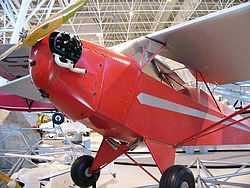Continental A40
The Continental A40 engine is a carbureted four-cylinder, horizontally opposed, air-cooled aircraft engine that was developed especially for use in light aircraft by Continental Motors. It was produced between 1931 and 1941.[1][2][3]
Design and development
The 37 hp (28 kW) A40 was introduced in the depths of the Great Depression. At the time there were a number of small engines available but all suffered from either high cost, complexity, or low reliability. The A-40 addressed all those shortcomings and was instrumental in the production of light aircraft in the difficult economic constraints of the period. The A-40-4 introduced an increase in power to 40 hp (30 kW). The engine later inspired the A-50 and subsequent engines.[1][2][4]
The A40 featured single ignition until the A-40-5 version, which introduced dual ignition. All engines in this family have a 5.2:1 compression ratio and were designed to run on fuel with a minimum octane rating of 73.[2][3]
The entire family of engines had its certification terminated on 1 November 1941. Engines produced before that date are still certified, but none can be produced after that date.[2][3]
Variants
- A40
- Single ignition, 37 hp (28 kW) at 2550 rpm, dry weight 144 lb (65 kg)[2]
- A40-2
- Single ignition, 37 hp (28 kW) at 2550 rpm, dry weight 144 lb (65 kg)[2]
- A-40-3
- Single ignition, 37 hp (28 kW) at 2550 rpm, dry weight 144 lb (65 kg)[2] Featured cadmium-nickel connecting rod bearings.[5]
- A40-4
- Single ignition, 40 hp (30 kW) at 2575 rpm, dry weight 144 lb (65 kg),[2] Steel backed connecting rod inserts
- A40-5
- Dual ignition, 40 hp (30 kW) at 2575 rpm, dry weight 156 lb (71 kg)[3]
Applications

- Aeronca KC[6]
- Piper J-2 Cub[1]
- Piper J-3 Cub[7][8]
- Porterfield Collegiate[6]
- Rose Parakeet[6]
- Taylor E-2 Cub[1]
- Taylorcraft A[6]
- Welch OW-5M[9]
Engines on display
Specifications (A40-5)
Data from Type Certificate Data Sheet 72,[2] Jane's 1938[10]
General characteristics
- Type: 4-cylinder air-cooled horizontally opposed aircraft piston engine
- Bore: 3.125 in (79.3 mm)
- Stroke: 3.75 in (95.3 mm)
- Displacement: 115 in³ (1.9 L)
- Length: 27.9375 in (710 mm)
- Width: 26.4375 in (672 mm)
- Height: 20.4375 in (519 mm)
- Dry weight: 154 lb (69.9 kg) dry with carburrettor and magnetos
Components
- Valvetrain: One intake and one exhaust side-valve per cylinder with a flathead valve design.
- Fuel system: CMC Stromberg NA-82 carburetor
- Fuel type: minimum 73 octane
- Cooling system: Air-cooled
Performance
- Power output: 40 hp (30 kW) at 2,575 rpm
- Specific power: 0.35 hp/in³ (15.3 kW/L)
- Compression ratio: 5.2:1
- Specific fuel consumption: 0.72 lb/hp/hr (0.439 kg/kW/hr)
- Oil consumption: 0.025 lb/hp/hr (0.0153 kg/kW/hr)
- Power-to-weight ratio: 0.28 hp/lb (0.45 kW/kg)
See also
- Related lists
References
- ↑ 1.0 1.1 1.2 1.3 1.4 "Continental A-40". Old Rhinebeck Aerodrome. Retrieved 2011-09-26.
- ↑ 2.0 2.1 2.2 2.3 2.4 2.5 2.6 2.7 2.8 Federal Aviation Administration (November 1941). "Approved Type Certificate 72" (PDF). Retrieved 2008-12-15.
- ↑ 3.0 3.1 3.2 3.3 Federal Aviation Administration (November 1941). "Approved Type Certificate 174" (PDF). Retrieved 2008-12-15.
- ↑ Christy, Joe: Engines for Homebuilt Aircraft & Ultralights, pages 8-9. TAB Books, 1983. ISBN 0-8306-2347-7
- ↑ Sport Aviation. December 1959.
- ↑ 6.0 6.1 6.2 6.3 Wooden props (2008). "Fahlin Propellers". Retrieved 2008-12-13.
- ↑ "ATC 660 data sheet" (PDF). Federal Aviation Administration. Retrieved 2011-09-27.
- ↑ "Aircraft Specification No. A-691" (PDF). Federal Aviation Administration. Retrieved 2011-09-27.
- ↑ "TC 637 data sheet" (PDF). Federal Aviation Administration. Retrieved 2011-09-26.
- ↑ Jane's All the World's Aircraft 1938. London: Sampson, Low & Martin company Limited. 1938.
External links
| Wikimedia Commons has media related to Continental A-40. |
- E-2 "Cub" Powerplant Instl - Holcomb's Aerodrome. The A-40, as installed in the Taylor E-2 Cub.
| |||||||||||||||||||
| ||||||||||||||